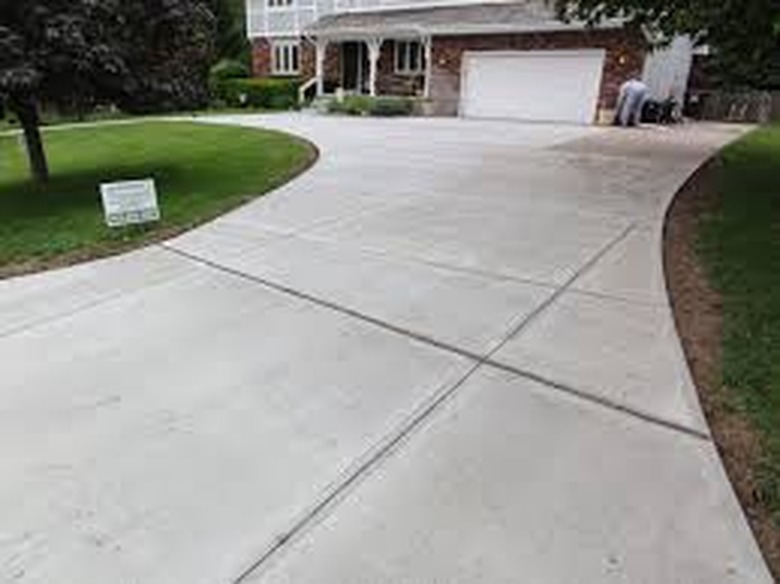How To Repair Cracks In Concrete
We may receive a commission on purchases made from links.
Concrete is one of the oldest and most durable building materials, but as anyone with a foundation wall or driveway can attest, concrete is prone to cracking. A crack in itself is not always a major structural problem: but the larger issue is that cracks grow. Especially in colder climates, concrete cracks are vulnerable to the freeze/thaw cycle. They fill up with water, the water freezes, and the crack expands, potentially leading to structural failure.
The good news is that concrete cracks are easy to fix. And when repaired correctly, you can preserve the structural integrity of your concrete wall, driveway, patio, swimming pool or sidewalk.
Determine Whether it's a Live Crack
Determine Whether it's a Live Crack
Cracks in concrete always happen for a reason. In almost all cases, cracks are caused by one of two things: stress or drainage issues. Settling of foundation walls and other forms of movement create internal forces within the concrete, resulting in cracks and other forms of damage. Or, inadequate drainage allows water pressure to build up around concrete walls, which can also result in stress-related cracking.
When you discover a crack in a concrete structure, it is always a good idea to mark the ends of the cracked area and to measure the width of the crack at its widest point. Monitor it for a few weeks: If the crack continues to elongate or grow wider, it is a live crack and your best option is to consult an inspector or structural engineer to help identify and remedy the source of the crack.
Prepare the Concrete for Repair
Prepare the Concrete for Repair
Whether the concrete crack you have encountered is on a flat, horizontal surface (such as a driveway, or a vertical surface like a basement foundation wall), the repair procedure is pretty much the same. The key is to get rid of as much of the failing concrete as you can.
Use a cold chisel and a maul (a handheld sledge) to remove the loose concrete (be sure to wear safety gear, especially eye protection, and a particle mask). The goal is to create a dovetail-shaped keyway in and around the crack. It should be wider at the base than at the top so the concrete repair product will not simply fall out of the crack when it hardens. This is the hardest part of the procedure. Avoid using grinders or other mechanical tools, as you should be trying to keep as much of the original concrete intact as you can while still chiseling out a keyway of the correct shape.
Once you have chiseled out all of the loose material and shaped a dovetail keyway, use a wire brush to remove any remaining debris and wipe the repair area with water — or, if you have any oil-based stains in the area, use a concrete/asphalt detergent or even dishwashing detergent. Let the repair area dry and then prepare it with a thin coat of latex-based concrete bonding agent, which is especially important for cracks wider than 1/16 inch.
How to Repair Large Cracks in Concrete
How to Repair Large Cracks in Concrete
For larger cracks, use a cementitious concrete repair mix. These dry powder mixes have small aggregate so they can conform to small and angular spaces, but otherwise are formatted in much the same way as bagged concrete mix.
- Follow the mixing instructions on the packaging — it is almost always a good idea to use latex bonding agent as the liquid additive instead of plain water, although many products sold today do have vinyl or latex additive premixed in so you don't have to add bonding agent unless you really want to. The latex (or in some cases polymerized) fluid makes the repair product more pliable and spreadable, and it also adds to its flexibility after it cures so it can move slightly.
- Apply the repair mix with a pointing trowel, pressing it into the crack firmly and overfilling just a bit. Make sure to wear gloves, as the Portland cement in these products is caustic to skin.
- Smooth the surface with the trowel once it has set up, bringing it to bring it level with the surrounding surfaces. If the concrete structure being repaired has a texture, you can use a wire brush to blend the repair in, but try to do it before the concrete product has hardened — within an hour of application.
Tip
Cementitious concrete repair products are paintable (when cured) with any masonry paint or sealer you would otherwise use on your wall or driveway, including epoxy-based garage floor paint.
Quick Fixes: How to Repair Small Cracks in Concrete
Quick Fixes: How to Repair Small Cracks in Concrete
Smaller cracks (less than 1/16 inch wide) can simply be caulked with a concrete crack repair product. Sold in cartridges, these products are traditionally polyurethane based, although some newer products are created with less caustic polymers or may even use epoxy. Because these products have very high adhesion, carving out a dovetail-shaped keyway is generally not necessary — just clean out the crack with a wire brush, rinse, and apply the product with a caulk gun according to the package instructions. While convenient and highly flexible (which is good), making repairs with these products does have one downside in that the repair product can't normally be shaped or sanded after application, and many do not take paint well.
Final Note
Final Note
Whether you trowel in a dry powder repair mix or inject a polymerized product from a caulking cartridge, your main objective should be to get the repair taken care of as soon as possible, especially in an exterior environment. Once you have effected the fix, keep an eye on the crack to see if it is live, and contact a structural engineer if the crack continues to widen or lengthen after the repair.


